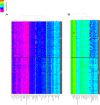The effect of acute moderate-intensity exercise on the serum and fecal metabolomes and the gut microbiota of cross-country endurance athletes
- PMID: 33574413
- PMCID: PMC7878499
- DOI: 10.1038/s41598-021-82947-1
The effect of acute moderate-intensity exercise on the serum and fecal metabolomes and the gut microbiota of cross-country endurance athletes
Abstract
Physical exercise can produce changes in the microbiota, conferring health benefits through mechanisms that are not fully understood. We sought to determine the changes driven by exercise on the gut microbiota and on the serum and fecal metabolome using 16S rRNA gene analysis and untargeted metabolomics. A total of 85 serum and 12 fecal metabolites and six bacterial taxa (Romboutsia, Escherichia coli TOP498, Ruminococcaceae UCG-005, Blautia, Ruminiclostridium 9 and Clostridium phoceensis) were modified following a controlled acute exercise session. Among the bacterial taxa, Ruminiclostridium 9 was the most influenced by fecal and serum metabolites, as revealed by linear multivariate regression analysis. Exercise significantly increased the fecal ammonia content. Functional analysis revealed that alanine, aspartate and glutamate metabolism and the arginine and aminoacyl-tRNA biosynthesis pathways were the most relevant modified pathways in serum, whereas the phenylalanine, tyrosine and tryptophan biosynthesis pathway was the most relevant pathway modified in feces. Correlation analysis between fecal and serum metabolites suggested an exchange of metabolites between both compartments. Thus, the performance of a single exercise bout in cross-country non-professional athletes produces significant changes in the microbiota and in the serum and fecal metabolome, which may have health implications.
Conflict of interest statement
The authors declare no competing interests.
Figures





References
-
- Denou E, Marcinko K, Surette MG, Steinberg GR, Schertzer JD. High-intensity exercise training increases the diversity and metabolic capacity of the mouse distal gut microbiota during diet-induced obesity. Am. J. Physiol. Endocrinol. Metab. 2016;310:E982–E993. doi: 10.1152/ajpendo.00537.2015. - DOI - PMC - PubMed
Publication types
MeSH terms
Substances
LinkOut - more resources
Full Text Sources
Other Literature Sources
Medical

